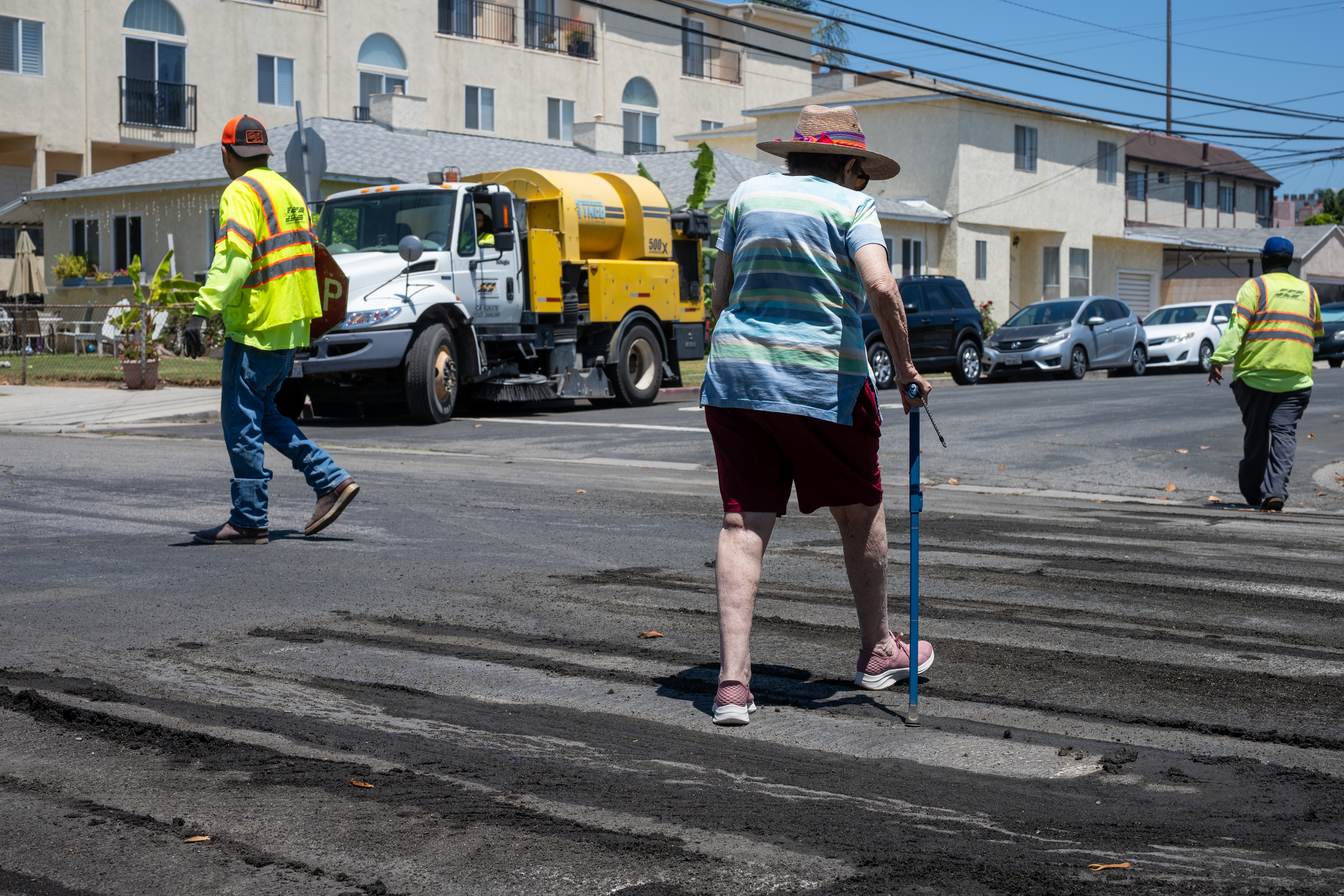In late spring, a group of residents on the Westside of LA took it upon themselves to paint crosswalks at several intersections around Stoner Park, citing concerns about pedestrian safety and slow response times from the city. The effort, which took place over four weekends, involved volunteers using traffic-grade paint to mark unmarked intersections that already functioned as legal crosswalks under California law.
Jonathan, a local resident who frequents the park, led the initiative. He said the group focused on intersections with stop signs and proximity to a nearby school, aiming to align with state guidelines for school zones. “I didn’t want to wait for a kid or dog to get hurt or killed before we did something,” he said.
Volunteers used yellow paint, citing state rules that designate yellow striping for crosswalks within 600 feet of schools. One corner of the park, at Missouri Avenue and Westgate, falls within that range. According to Jonathan, the painted crosswalks helped improve driver behavior. He observed more vehicles slowing down and yielding to pedestrians after the markings were added.
 However, within 72 hours of a local media report on the project, city crews arrived to remove the markings. The city deployed heavy equipment including two skid steers, an industrial pressure washer, and a street sweeper to scrape off the paint. Residents reported that a thin layer of pavement was also removed in the process, leaving visible scars where the crosswalks had been.
However, within 72 hours of a local media report on the project, city crews arrived to remove the markings. The city deployed heavy equipment including two skid steers, an industrial pressure washer, and a street sweeper to scrape off the paint. Residents reported that a thin layer of pavement was also removed in the process, leaving visible scars where the crosswalks had been.
“It’s kind of a gut punch that it happened so soon,” Jonathan said. “There was probably a meeting where they were like, we need to address this ASAP. This cannot stand.”
The city did not provide advance notice to the residents who painted the crosswalks, and efforts to speak with the workers on site were unsuccessful, according to Jonathan.
Los Angeles has long faced criticism over the pace at which it installs pedestrian safety infrastructure. Residents across the city have reported years-long waits for crosswalks, speed humps, stop signs, and other traffic-calming measures. In some instances, safety improvements have only been made following serious injuries or fatalities. At the same time, the city has demonstrated the ability to mobilize quickly in response to unapproved alterations. In recent years, unauthorized crosswalks painted by grassroots groups like the Crosswalk Collective were removed within days.
The response to such community-led projects stands in contrast to the city’s progress on its own traffic safety goals. In 2015, Los Angeles adopted a Vision Zero plan to eliminate traffic deaths by 2025. Since then, annual fatalities have increased. In 2022, 312 people were killed in traffic collisions on city streets, including 159 pedestrians—the highest number in two decades.
 Meanwhile, the city continues to invest heavily in enforcement-related operations, including daily encampment sweeps involving LA Sanitation and the LAPD. In 2023, the city allocated more than $30 million to these operations, while reducing services such as mobile showers and restrooms at encampments. There are only 14 permanent public toilets citywide, and unhoused residents frequently report the absence of trash pickup or safe parking areas.
Meanwhile, the city continues to invest heavily in enforcement-related operations, including daily encampment sweeps involving LA Sanitation and the LAPD. In 2023, the city allocated more than $30 million to these operations, while reducing services such as mobile showers and restrooms at encampments. There are only 14 permanent public toilets citywide, and unhoused residents frequently report the absence of trash pickup or safe parking areas.
Critics have noted the disparity in how quickly the city acts to remove encampments or unauthorized improvements, compared to the delays in implementing basic infrastructure or services. Los Angeles has also faced costly litigation over traffic-related injuries and deaths. In one case, the city paid $15 million to the family of a girl killed at an intersection where residents had previously requested safety measures. In another, the same amount was paid to a pedestrian who suffered permanent brain damage after being struck at a poorly marked crosswalk.
Jonathan said he intends to give the city one week to either reinstall the crosswalks or offer a path for legal community involvement. If not, he said, he and other residents are prepared to repaint them. “They can easily put new crosswalks in if they want to,” he said. “I have the paint. I have the rollers. I’ll do it.”

